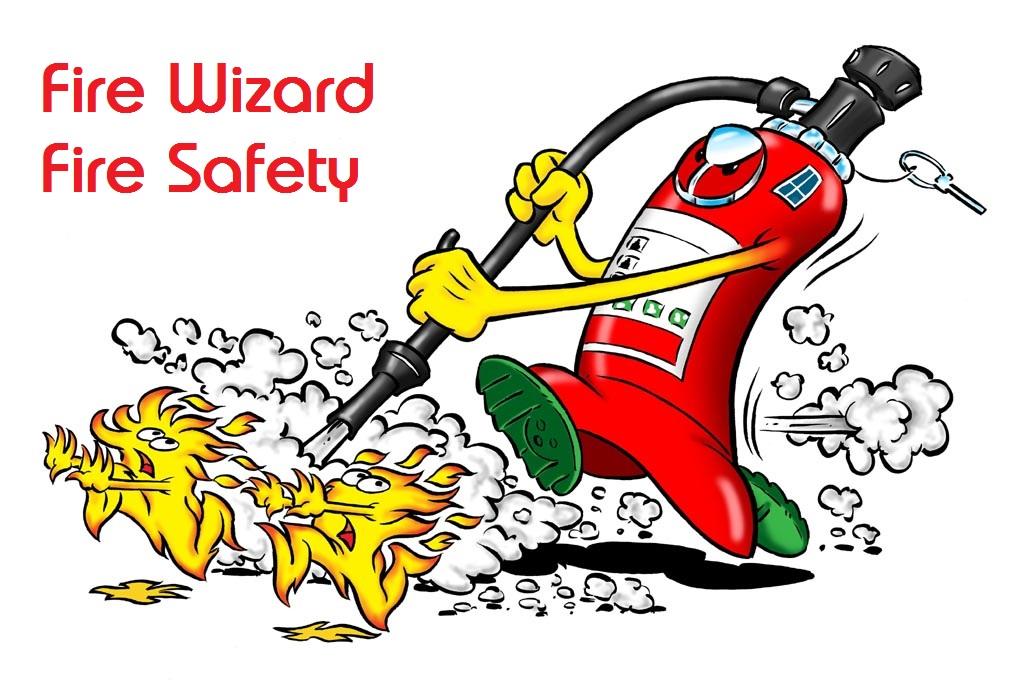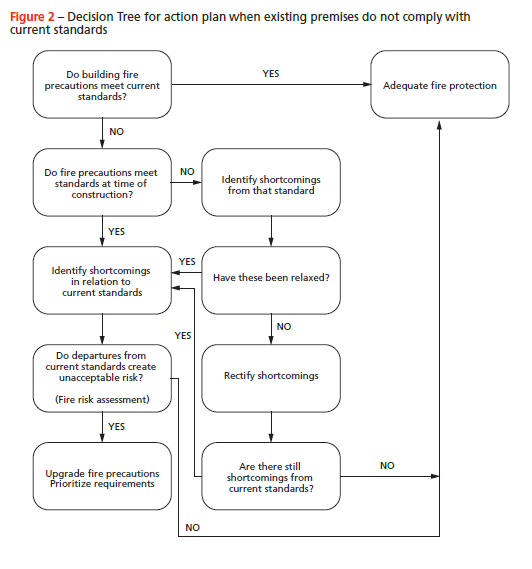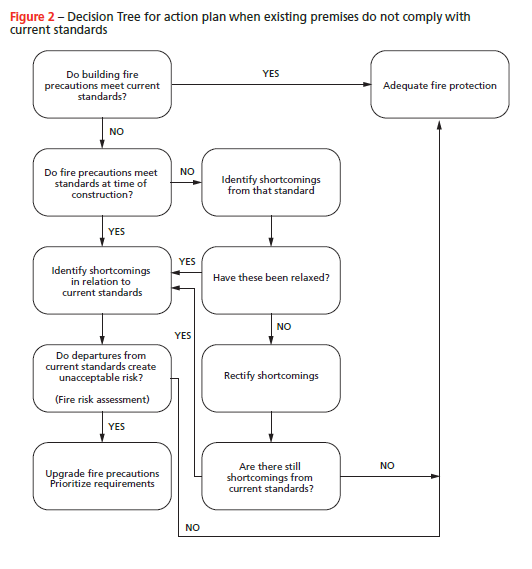-
Posts
2,707 -
Joined
-
Last visited
Everything posted by AnthonyB
-
Not at all. Only CO2 extinguishers require hydro testing in the UK & EU, all the other types, being lower pressure, are specifically exempted from pressure vessel safety regulations. (A technical exception to this is if they are renovated by being shotblasted and repainted, but this isn't usually done with non CO2 types anymore as new equipment prices make it not cost effective) They do require testing by discharge every 5 years as part of an Extended Service.
-
That's OK - I had to think for a while to work out the best way!
-
"A building of approx xxm height with flats off eight half landings" ?
-
If the door was a compliant fire door in the past then assuming the block meets the other fire safety conditions for flats and based on the size of the premises it would be acceptable now under the current guidance. If it's not compliant it will be her door and if she refuses to change it then they should be reported to the local authority for enforcement under the Housing Act.
-
It's a protected shaft, complies with Building Regulations and other fire safety guidance. It's an urban myth that these need stopping routinely and sadly many building owners have wasted money on doing this either on the advice of those who don't know what they are doing or are fleecing the owner as they also do the works.
-

How often do we need to certify emergency lighting?
AnthonyB replied to a topic in Emergency Lighting
You need to evidence your system of maintenance, a certificate is one way of doing this but not exclusive. -
They need to meet the minimum lighting level for the area - e.g. 1 lux on escape routes, 0.5 lux for open areas, etc.
-
If installed properly and proper pre-made they can comply, something knocked up on site probably won't....the felt barrier isn't allowed to be loose either and should be mechanically fastened. This should help http://www.nhbc.co.uk/Builders/ProductsandServices/TechZone/NHBCStandards/TechnicalGuidanceDocuments/72/filedownload,75082,en.pdf
-
The test switch is a safe way to cause a permanent mains failure to the emergency fittings for both the monthly function test and annual duration test. Many older existing installations don't have them, but newer/new ones should if complying with BS5266
-

Internal Fire Doors, UK 3 Story Flats
AnthonyB replied to 78finn's topic in Fire Doors and Accessories
For decades in the past it was a Building Regulation requirement for certain internal doors in dwellings (especially flats) to be self closing fire doors, but for a long time now that requirement has been removed and they just need to be fire doors. Most of the time the chains were cut or doors propped so it was considered pointless and better to allow free swing and educate to close at night. -
Without seeing I cannot be 100% but you sound like you will have more than enough exits and width for your occupancy and no travel distance issues.
-
Well BS9999 is out of the window as few Heritage buildings will meet all it's requirements, it's usually the English Heritage guidance along with the usual guides
-
Doors to the outside don't need self closers, internal doors often do. Those inside the flats don't anymore, but the front doors into internal common areas do and have done for a very long time - if your conversion is of a former house it may have been done not in compliance with Building Regulations if they have never been fitted. Concealed closers are allowed if to BSEN 1154 & correctly installed - whilst most aren't it is possible to get ones that are.
- 68 replies
-
- door closer
- fire door
-
(and 1 more)
Tagged with:
-
It doesn't even still meet the 1965 standards if the compartmentation has been breached and the original fire doors in poor order - breaching both the legal requirement to maintain in effective working order and to protect means of escape and mitigate the effects of fire. To determine if it's a legal requirement to modernise go through this tree:
-

Installing fire detection gear in Commercial office
AnthonyB replied to a topic in Fire Alarm Systems
I''ve answered this duplicate post where it's first been posted. -
Powder would still be appropriate in your premises and still fully within the guidance in BS5306-8 on it's use. It is the best extinguisher for running fires and has a rapid knockdown. You do need to be aware of the damage potential though. Certain solvents are known as polar solvents and destroy the foam blanket of standard foam extinguishers so you would need to consult the Material Safety Data Sheets for the materials you use as this may rule out the use of foam (Polar solvent resistant foam extinguishers are available but very expensive) The Class B rating on water mist is so poor that the extinguishers cannot be officially marked as suitable for these fires and wouldn't suit your risks. If you don't have polar solvents then there is a Foam Mist extinguisher (https://www.firedepot.co.uk/firechief-multimist-6l-foam-mist-extinguisher). If you did use normal foam spray (not mist) then as it stands in the UK you would need CO2 for any electrical risks (most foams aren't marked for electrical fires here)- it's also good for minor spot fires if you do welding as it's non damaging.
-

Installing fire detection gear in Commercial office
AnthonyB replied to Richard James's topic in Landlords
As an office the minimum requirement, both under Building Regulations, Government fire safety guidance and the commercial fire alarm standard BS5839-1 is a Category M fire alarm system with a control panel, alarm sounders and break glass manual call points. Only if desired for property protection (in which case the alarm would need monitoring) or if there is an unusual layout affecting means of escape (e.g. an Inner room) would detection be required and even then not in every room or stair. As a landlord providing a Category M system meets your obligations and the tenant's fit out and desire for property protection should determine if they need to or wish to add detection - in which case they should pay the cost of the additions which should be to the main system (not adding separate equipment). The cost of a proper fire alarm system can be reduced by specifying a twinwire system (such as Alarmsense) as instead of there having to be separate cabling for callpoints/detectors and for sounders you can put call points/detectors/sounders on the same cabling. Mains smoke alarms are for BS5839-6 systems in dwellings and are not intended for commercial premises (No call points, no fault monitoring, no fire resistant cabling, etc) -

Warehouse offices storage under the stairs
AnthonyB replied to Mersey's topic in Fire Risk Assessments
It would be normal practice to protect the stair by underdrawing it to 30 minutes fire resistance using plasterboard or glass reinforced plasterboard of the required thickness (usually 12.5mm, the British Gypsum White Book gives suitable detail). -

Hmo comunal area,fire safety alarm,which level grade?
AnthonyB replied to a topic in Fire Risk Assessments
How many floors? The full specifications can be found here: https://www.rla.org.uk/docs/LACORSFSguideApril62009.PDF -
The legislation didn't cover social housing landlords as it wasn't considered necessary as they were deemed to be responsible and unlike the 'rogue' private sector not needing extra legislation. The Housing Act still applies and is enforced by the council via the housing health and safety rating system (HHSRS) - lack of suitable provision of smoke alarms would be a hazard enforceable under this system.
-
The default approach in an FRA would be to ensure the cupboard had an FD30S door kept locked shut or be taken from use - but the legislation & guidance is risk based and in theory in a managed use communal area use as it is for non combustible items could be tolerable. I have risk assessed a set of flat blocks with a very active and involved tenants/owners management committee and tenants/owners that are similarly cooperative and was able to allow managed communal area use and some non fire resisting cupboard doors in the FRA with the support of local enforcement officers. Having said that such a situation is sadly an exception and in many blocks zero tolerance and 'belt & braces' precautions are the only realistic approach. So flexibility is possible, but it requires buy in from all residents to ensure it's workable.
-
Even a new fire door does not have to have third party certification, so as long as they are inspected and maintained by a competent person and replaced if genuinely beyond repair then that should suffice.
-
There's nothing stopping a fire exit being in normal access route from a fire safety point of view, usually it's a security issue where access is limited to just one normal door.
-

Flat fire door for private entrance
AnthonyB replied to Nibarb's topic in Fire Doors and Accessories
p97-100 https://www.local.gov.uk/sites/default/files/documents/fire-safety-purpose-built-04b.pdf



